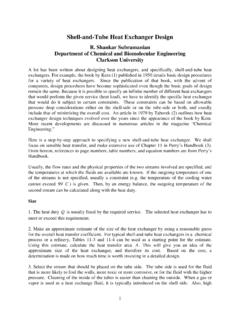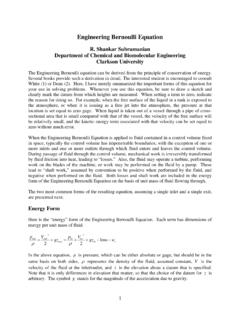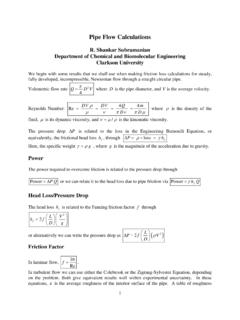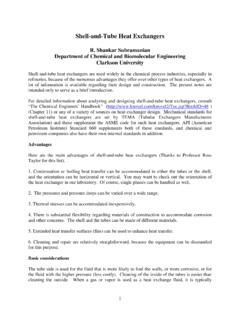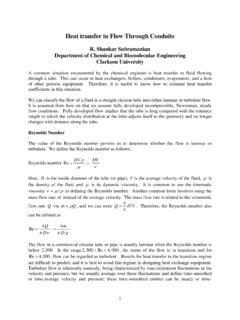Transcription of Pressure drop calculation for the shell side in shell-and ...
1 1 shell Side Pressure drop in a shell -and-Tube Heat Exchanger R. Shankar Subramanian Department of Chemical and Biomolecular Engineering clarkson University There are several ways to estimate the Pressure drop for the flow of the shell -side fluid in a shell -and-tube heat exchanger. A ball-park estimate can be obtained by the relatively simple approach described below, which is given in a book by Peters, Timmerhaus, and West (1). This book also provides much valuable information on the design of such heat exchangers, including more sophisticated methods of estimating the Pressure drop .
2 The Pressure drop on the shell -side is calculated using () BshellesfG D NPD + = In this equation, f is a Fanning friction factor for flow on the shell side given in Figure 14-44 of reference (1), sG is the mass velocity on the shell side, sD is the inside diameter of the shell , BN is the number of baffles, is the density of the shell -side fluid, and eD is an equivalent diameter. The mass velocity /smG mS=, where mis the mass flow rate of the fluid, and mS is the crossflow area measured close to the central symmetry plane of the shell containing its axis.
3 This area is defined as clearanceCross flow areapitchsBDL= where BL is the baffle spacing, and the clearance and pitch are defined in the notes on shell -and-tube heat exchangers. The equivalent diameter is defined as follows. 220044pneDCSDD = Here, 0D is the outside diameter of the tubes, and nS is the pitch (center-to-center distance) of the tube assembly. The constant 1pC= for a square pitch, and for a triangular pitch. The friction factor f is given in Figure 14-44 of the book as a function of the Reynolds number based on the equivalent diameter (Note the difference from the Reynolds number that we use for the heat transfer coefficient from Holman, which uses 0D as the length scale).
4 For the friction factor graph, we must use the Reynolds number Re defined as 2 ReesDG = where is the viscosity of the shell -side fluid. Reference 1. Peters, , Timmerhaus, , and West, , Plant Design and Economics for Chemical Engineers, McGraw-Hill, New York, 2003.

